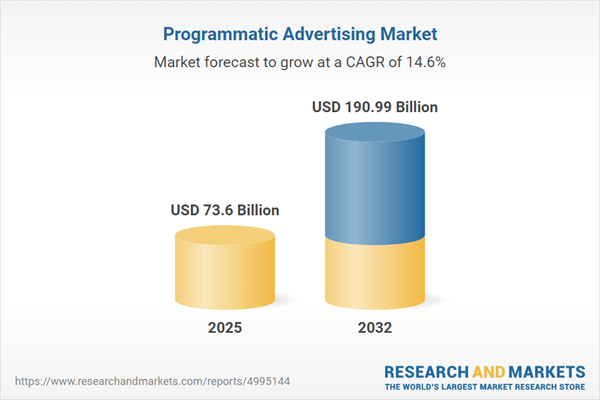Speak directly to the analyst to clarify any post sales queries you may have.
Programmatic advertising is reshaping digital marketing by combining automation, data-driven targeting, and advanced technology to help organizations refine audience engagement with precision and efficiency. This analysis distills the forces shaping the global market and presents actionable insights to power informed decision-making for industry leaders.
Market Snapshot: Programmatic Advertising Market Growth
The programmatic advertising market grew significantly, rising from USD 64.21 billion in 2024 to USD 73.60 billion in 2025. It is projected to sustain a robust CAGR of 14.59%, reaching USD 190.99 billion by 2032. Growth is underpinned by ongoing advancements in algorithmic media buying, rapid multi-channel adoption across digital environments, and the growing imperative for marketers to maximize performance with real-time data.
Scope & Segmentation of the Programmatic Advertising Market
- Channels: Audio (podcast, streaming), display (banner, rich media), and video (in-stream, out-stream) environments are each seeing tailored creative approaches and strategic investment.
- Device Types: Campaigns target audiences across connected TV, desktop, smartphone, and tablet, reflecting distinct patterns in usage and attribution.
- Industry Verticals: Automotive (aftermarket, new vehicles), BFSI (banking, insurance, investment services), CPG, healthcare (medical devices, pharma), media and entertainment (music streaming, publishing, video streaming), retail (apparel, electronics, grocery), telecom, and travel (airline, hotel, OTA) each present unique priorities and adoption curves.
- Regions: Insights cover the Americas, Europe, Middle East & Africa, and Asia-Pacific, offering detailed breakdowns at the country level across mature and emerging markets.
- Technologies: Research addresses the expanding role of artificial intelligence, machine learning, data management platforms, demand- and supply-side platforms, and identity solutions.
- Key Players: The analysis includes Alphabet Inc., Meta Platforms, Amazon.com, The Trade Desk, Verizon Communications, Adobe, Criteo, Microsoft, PubMatic, and Magnite, focusing on recent developments and differentiators.
Key Takeaways for Senior Decision-Makers
- Global privacy regulations are driving a paradigm shift toward first-party data strategies and privacy-centric identity resolution, with increased investment in contextual targeting and data clean rooms.
- Artificial intelligence and machine learning technologies are transforming bid optimization, creative personalization, yield management, and fraud detection, offering measurable improvements in return on ad spend and process efficiency.
- Rapid expansion of connected TV, audio streaming, and enriched display formats highlights the growing complexity of the media mix and underscores the need for supply path optimization and advanced header bidding architectures.
- Industry-specific strategies allow advertisers to customize creative, channel selection, and measurement models, with significant demand variation across automotive, BFSI, healthcare, and retail sectors.
- Competitive dynamics favor organizations that develop integrated partnerships and transparent technology stacks, leveraging both established platforms and emerging innovators to remain agile in a fast-evolving marketplace.
Impact of Tariff Adjustments on Market Dynamics
Projected tariff changes in the United States for 2025 are anticipated to increase hardware and infrastructure costs within the programmatic supply chain. This may influence expenditures for servers, network devices, and connected screen hardware, prompting both vendors and advertisers to reassess partnerships and budget allocation. Adaptation strategies include diversifying supplier networks, renegotiating service terms, and implementing buffer measures to sustain operational resilience as input costs fluctuate.
Methodology & Data Sources
This report is anchored in comprehensive quantitative and qualitative research. Secondary research utilized industry publications and regulatory filings, while primary research captured perspectives from senior executives, ad operations specialists, and technology providers. Quantitative analysis incorporated usage data, bid stream analytics, and custom surveys, all validated by peer reviews and independent cross-checks.
Why This Report Matters for Market Leaders
- Enables data-driven investment decisions through channel, device, and industry segmentation aligned with current trends and evolving technologies.
- Offers a clear view of global regulatory changes, cost pressures, and competitive dynamics, equipping organizations to mitigate risk and seize growth opportunities.
- Delivers actionable recommendations for enhancing data strategies, media partnerships, and campaign optimization in the programmatic advertising landscape.
Conclusion
The programmatic advertising market is evolving swiftly in response to technology advances, privacy imperatives, and regional shifts. This report enables decision-makers to align resources, innovate strategically, and succeed in an increasingly complex environment.
Additional Product Information:
- Purchase of this report includes 1 year online access with quarterly updates.
- This report can be updated on request. Please contact our Customer Experience team using the Ask a Question widget on our website.
Table of Contents
3. Executive Summary
4. Market Overview
7. Cumulative Impact of Artificial Intelligence 2025
Companies Mentioned
The companies profiled in this Programmatic Advertising market report include:- Alphabet Inc.
- Meta Platforms, Inc.
- Amazon.com, Inc.
- The Trade Desk, Inc.
- Verizon Communications Inc.
- Adobe Inc.
- Criteo S.A.
- Microsoft Corporation
- PubMatic, Inc.
- Magnite, Inc.
Table Information
| Report Attribute | Details |
|---|---|
| No. of Pages | 198 |
| Published | November 2025 |
| Forecast Period | 2025 - 2032 |
| Estimated Market Value ( USD | $ 73.6 Billion |
| Forecasted Market Value ( USD | $ 190.99 Billion |
| Compound Annual Growth Rate | 14.5% |
| Regions Covered | Global |
| No. of Companies Mentioned | 11 |









